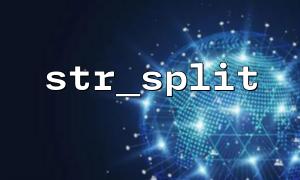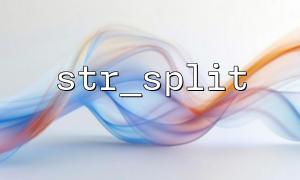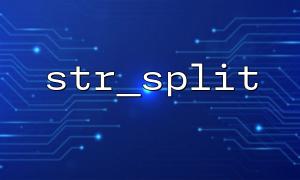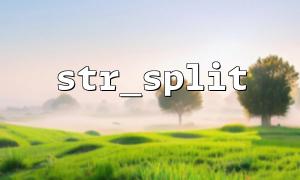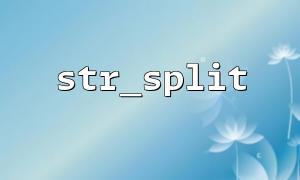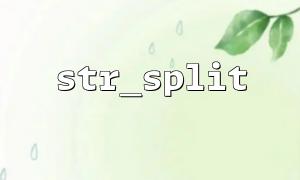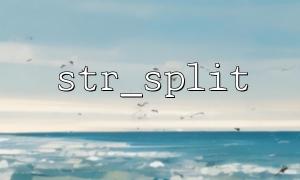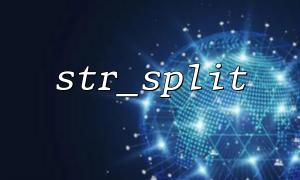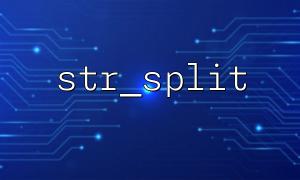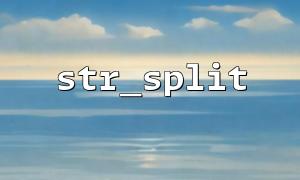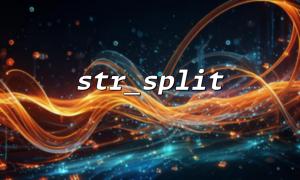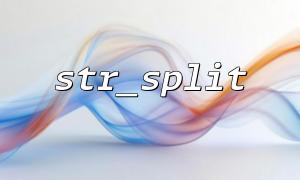In web development, sometimes we want to display a string according to specific rules or layout to achieve imagery. For example, we can split each character of a string into small pieces and arrange it in different ways to create creative and visually attractive effects. Today, we will explore how to achieve the image distribution effect of strings through the str_split function in PHP.
In PHP, str_split() is a very practical string processing function. Its function is to split a string into an array of specified length and return an array containing split characters. The basic syntax is as follows:
str_split(string $string, int $length = 1): array
$string : The string to be split.
$length : The character length of each array element, default is 1.
For example:
$string = "Hello, World!";
$result = str_split($string, 3);
print_r($result);
Output:
Array
(
[0] => Hel
[1] => lo,
[2] => Wo
[3] => rld
[4] => !
)
We can use str_split() to split the string into several character blocks, and then format it with CSS or HTML to produce an image-like layout effect. For example, each character block can be displayed as a separate "image" and the position and style of each character block can be adjusted according to the specific needs.
First, we split the string into multiple character blocks and arrange these character blocks horizontally through CSS. This effect is similar to presenting each character as an image.
<?php
$string = "PHP is awesome!";
$char_array = str_split($string);
echo "<div style='display: flex;'>";
foreach ($char_array as $char) {
echo "<div style='margin: 5px; font-size: 24px;'>$char</div>";
}
echo "</div>";
?>
The above code first uses the str_split() function to split the string "PHP is awesome!" into a character array, and then loops through the array and wraps each character with the div tag. In HTML, we use display: flex to arrange these character blocks horizontally to produce an imaged effect.
If we want the character block to be rendered in a grid, we can control the size of each block and adjust its position. For example, suppose we split the string into 5 characters per line to form an image-like grid layout.
<?php
$string = "PHP is awesome and powerful!";
$char_array = str_split($string);
$columns = 5; // Number of characters per line
$rows = ceil(count($char_array) / $columns); // Calculate the number of rows
echo "<div style='display: grid; grid-template-columns: repeat($columns, 1fr); grid-gap: 5px;'>";
foreach ($char_array as $char) {
echo "<div style='padding: 10px; background-color: #f0f0f0; text-align: center; font-size: 18px;'>$char</div>";
}
echo "</div>";
?>
In this example, we use grid layout to implement grid arrangement of characters. We make sure that 5 characters are displayed per line by adjusting grid-template-columns and use grid-gap to add spacing between each character block. This can achieve the image distribution effect of characters, like a simple "character image".
Sometimes we may want to adjust the arrangement of characters based on certain dynamic conditions or user interactions. For example, the style or position of a character can be changed according to a specific character in a string. You can use JavaScript or PHP backend logic to dynamically process character distribution to achieve more complex imagery effects.
For example, if we want each character to adjust its font size and color according to its position in the string, we can use the following code:
<?php
$string = "Dynamic String Example!";
$char_array = str_split($string);
echo "<div style='display: flex;'>";
foreach ($char_array as $index => $char) {
$font_size = 14 + ($index % 10); // Adjust the font size according to position
$color = $index % 2 == 0 ? "#ff6347" : "#4682b4"; // Change color according to position
echo "<div style='margin: 5px; font-size: {$font_size}px; color: {$color};'>$char</div>";
}
echo "</div>";
?>
In this example, we dynamically adjust the font size and color of the character according to the index position of the character. This can bring more dynamic effects to the string.
Through PHP's str_split function, we can split a string into several character blocks, and then use HTML and CSS to achieve different image distribution effects. Whether it is horizontal arrangement, grid arrangement, or dynamic arrangement, str_split provides us with a flexible foundation. By combining CSS layout skills and PHP's string processing capabilities, we can achieve many creative and visual impact effects.
I hope you can use str_split function in actual projects to create amazing image distribution effects!
